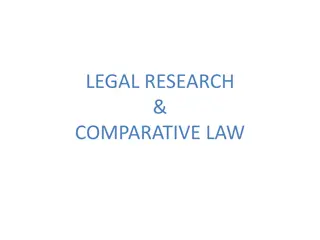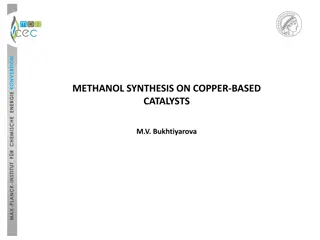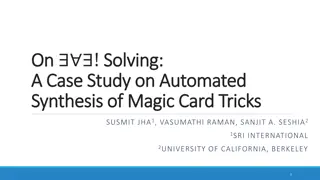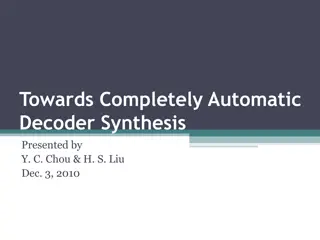Comparative Analysis of Bottom-up and Top-down Nanomaterial Synthesis Techniques
Bottom-up techniques yield individual nanoparticles with narrow size distributions, while top-down methods produce bulk nanostructured materials. Physical Vapour Deposition (PVD) and Inert Gas Condensation (IGC) are examples of bottom-up approaches capable of synthesizing nanomaterials with precise control at the nanoscale. PVD involves evaporating atoms from a source, while IGC combined with thermal evaporation is used to synthesize metallic and metal oxide nanopowders with defined size distributions. Both techniques have their advantages and applications, making them complementary in nanomaterial synthesis.
Download Presentation

Please find below an Image/Link to download the presentation.
The content on the website is provided AS IS for your information and personal use only. It may not be sold, licensed, or shared on other websites without obtaining consent from the author.If you encounter any issues during the download, it is possible that the publisher has removed the file from their server.
You are allowed to download the files provided on this website for personal or commercial use, subject to the condition that they are used lawfully. All files are the property of their respective owners.
The content on the website is provided AS IS for your information and personal use only. It may not be sold, licensed, or shared on other websites without obtaining consent from the author.
E N D
Presentation Transcript
Usually, the bottom-up techniques can give very fine nanostructures of individual nanoparticles, nanoshells, etc., with narrow size distributions, if the process parameters are effectively controlled. The top-down techniques do not usually lead to individual nanoparticles; however, they can produce bulk nanostructured materials. Many of the bottom-up approaches have difficulties in scale up, while the top-down approaches can be easily scaled up. Thus, one can see that both these approaches are complementary to each other, depending on the application. requirement of a particular
Bottom Up Approach :- 1.Physical Vapour Deposition Process :- PVD is a versatile synthesis method and is capable of preparing thin film materials with control at the nanometre scale by careful monitoring of the processing generation of vapour phase either via evaporation, sputtering, laser ablation or by using an ion beam. In evaporation, atoms are removed from the source, usually by heating it above its melting point. On the other hand, in sputtering, atoms are ejected from the target surface by the impact of energetic ions. Thermal evaporation has a limitation in multicomponent materials since one of the metallic elements typically evaporates before the other, due to the differences in boiling point and vapour species. conditions. PVD involves the pressure of the evaporating
On the contrary, sputtering is capable of depositing high melting point materials such as refractory metals and ceramics, which are difficult to convert to nanomaterials by evaporation. Sputtering can result in better stoichiometric control of the film compared to evaporation techniques. Sputter-grown films usually have higher density than those obtained by evaporation as the sputtered atoms have more energy than the evaporated atoms. Sputtered films are more prone to contamination than evaporated films due to the lower purity of the sputtering target materials.
A-Inert Gas Condensation (IGC):- (IGC) combined with thermal evaporation is commonly used to synthesise metallic and metal oxide nanopowders with a well-defined and narrow size distribution. In this process ( the principle of this process ) , a metal is evaporated inside an ultra-high vacuum (UHV) chamber filled with inert gas, typically helium (Fig.1). The vapourised species then loses energy via collisions with helium molecules. As collisions limit the mean free path, supersaturation can be achieved above the vapour source. At high supersaturation, the vapours rapidly form large numbers of clusters that grow via coalescence and agglomeration. The clusters in the condensing gas are transported by convective flow to a vertical cold finger surface filled with liquid nitrogen.
The removal of particles from the cold finger is carried out by a scrapern assembly. They are collected via a funnel and transported to an in situ compaction device or coated with a surfactant agent that prevents them from agglomeration. consolidation of particles are carried out under UHV conditions to prevent oxidation of the metallic nanoparticles. The size, morphology and yield of the clusters in gas condensation are dependent on three fundamental parameters: Rate of supply of atoms to the region of supersaturation where condensation occurs. Rate of energy removal from the hot atoms via the condensing gas medium. Rate of removal of clusters once nucleated from the supersaturated region. The scraping and
Particle nucleation, coalescence and growth during condensation also play key roles in forming small particles in large numbers. The main advantage of this technique is that it exhibits a higher production rate of about 60 g/h and a yield of 75%. Rapid overheating of the metal via radio frequency (RF) induction technique produces a high vapour pressure and substantial evaporation rate. The reactor is supplied continuously with cryogenic liquid, and nanoparticles are formed by rapid condensation of the supersaturated metal vapour. The condensation region, where the particles are formed by the nucleation, growth and coalescence processes, features a high temperature gradient. The low temperature of the surrounding medium produces a high rate of nucleation and rapid cooling of the as-formed particles limits crystal growth.
This technique is used for synthesis of different metal nano-powders such as (Fe, Cu, Al). IGC using a direct current (DC) or radio frequency (RF) magnetron sputtering source has been used to prepare refractory metal and ceramic nanoparticles. The gas pressure, sputter power and source substrate distance are crucial process parameters during sputtering and gas condensation. A careful selection of these parameters will lead to the successful formation of nanoparticles rather than the formation of a granular film.
Figure (1):- Schematic inert gas condensation unit for the synthesis of nanocrystalline particles.
B-Laser ablation:- Generally, laser ablation can provide better control of the evaporation process by congruent evaporation of constituent elements of multicomponent materials in a very short period of time. In this technique (the principle), an intense pulsed laser beam irradiates the target of interest, thereby vaporising atoms and clusters from the target. The total mass ablated from the target per laser pulse is usually referred to as the ablation rate.
Laser ablation in combination with inert gas condensation (IGC) is an attractive route to synthesize multicomponent nanocrystalline materials. A typical laser ablation set up is shown in Figure 2. In the process, atoms ablated by laser pulse tend to collide with helium gas, losing their kinetic energy rapidly. They eventually condense to form a cloud consisting of fine nanocrystalline clusters. The production rate of nanoparticles in this technique varies with helium gas pressure and laser pulse energy. This technique used to produce nanoparticles of metals, metal oxides and metal carbides. larger amounts of the























